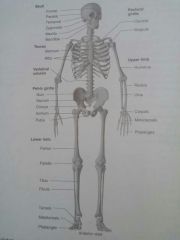![]()
![]()
![]()
Use LEFT and RIGHT arrow keys to navigate between flashcards;
Use UP and DOWN arrow keys to flip the card;
H to show hint;
A reads text to speech;
17 Cards in this Set
- Front
- Back
|
red marrow |

Where blood cells are made in the long bones |
|
|
Osteocytes |
What produces a hard, calcium rich extracellular matrix |
|
|
Skeleton |

A frame of more than 200 bones that make up the human |
|
|
Axial |
The portion of a skeleton that consists of the vertebrae, ribs, and sternum |
|
|
Appendicular |
Part of the skeleton that is made up of the bones of the shoulders, arms, pelvis, and legs. |
|
|
Joints |
Connect the bones of the skeleton |
|
|
Osteoarthritis |
A degenerative bone and joint disease |
|
|
Rheumatoid arthritis |
A degenerate joint disease caused by an autoimmune response |
|
|
Osteoporosis |
A disease caused by calcium loss often found in older people, especially postmenopausal women |
|
|
Ligaments |
Connect bones to other bones |
|
|
Tendons |
Connect muscle to bone |
|
|
Cartilage |
Cushions bones at the joints |
|
|
Cardiac muscle |
A type of muscle that is found only in the heart and is involuntary |
|
|
Smooth muscle |
Also involuntary, it's found in the internal organs of the digestive tract and blood vessels |
|
|
Skeletal muscle |
Also called striated muscle due to the microscopic appearance of the individual muscle cells, or fibers. Skeletal muscles move bones and are responsible for voluntary movements. Skeletal muscles, attached to bones by tendons, move the bones when they contract and thereby shorten |
|
|
Flexor muscle |
A muscle that bends are moving them away from anatomical position |
|
|
Extensor muscle |
A muscle that returns the limbs to the anatomical position |

